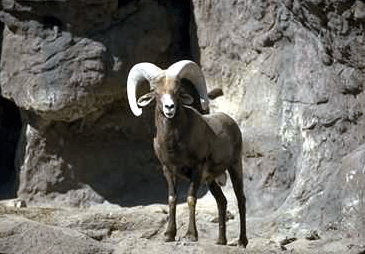

Bighorn
Sheep
Ovis
canadensis

|
Also called MOUNTAIN SHEEP, either of two similar North American sheep: the Canadian bighorn and the Dall sheep (O. dalli), both belonging to the family Bovidae (order Artiodactyla). The bighorn's body is compact and muscular; the muzzle, narrow and pointed; the ears, short and pointed; the tail, very short. Both sexes have transversely ribbed horns that, in the male, may curve in a spiral more than 1 m (39 inches) long on the outer curvature. The fur is deerlike and usually a shade of brown with a whitish rump patch; in the Dall sheep it varies from white to almost black. Height at the shoulder is about 1 m; the weight of rams reaches about 90 kg (200 pounds) in the Dall sheep, 155 kg in the Canadian bighorn. Bighorn live in the remote crags and cliffs of mountainous areas. Formerly, the Canadian bighorn ranged from northern Mexico to Canada, but it is now reduced to small bands protected by inaccessible habitat or by refuges. Dall sheep range from Alaska to British Columbia. Bighorn feed mainly on grasses, but in the desert mountains of the Southwest they eat shrubs and even cacti. Surefooted, they leap easily from rock to rock and climb seemingly sheer cliffs. The cloven hooves are sharp-edged, elastic, and concave. Bighorn breed in November and December, the rams battling for possession of the ewes. One or sometimes two lambs are born after six months' gestation. Bighorn are gregarious, but in summer the rams live apart from the ewes and lambs. Copyright 1994-1998 Encyclopaedia Britannica; image from Smithsonian Natural History Museum |